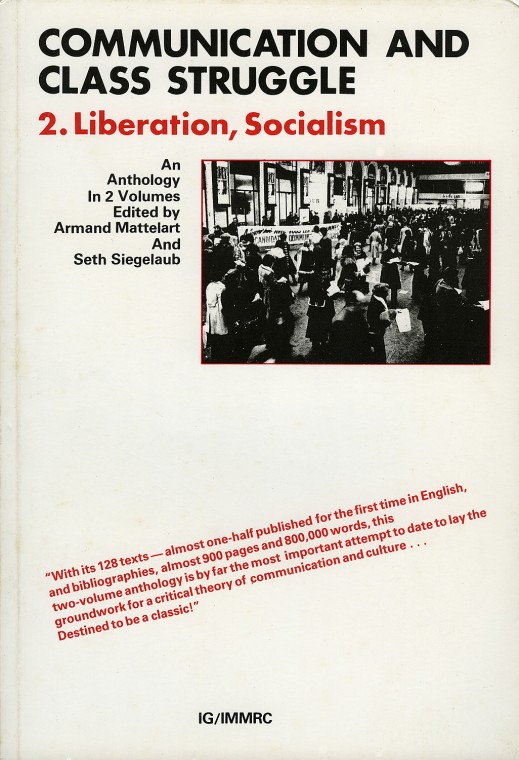Armand Mattelart, Seth Siegelaub (eds.): Communication and Class Struggle, 2: Liberation, Socialism (1983)
Filed under book | Tags: · aesthetics, communication, communism, everyday, information, left, life, machine, marxism, mass media, media, political economy, politics, socialism, theory

“Communication and Class Struggle, a two-volume work, is the first general marxist anthology of writings on communication, information and culture. Its purpose is to analyse the relationship between the practice and theory of communication and their development with the context of class struggle. Armand Mattelart and Seth Siegelaub, the editors, have selected more 128 essential marxist and progressive texts originating in over 50 countries and written since the mid-nineteenth century to explain three interrelated phenomena: (1) how basic social, economic and cultural processes condition communication; (2) how bourgeois communication practice and theory have developed as part of the capitalistic mode of production; and (3) how in the struggle against exploitation and oppression, the popular and working classes have developed their own communication practice and theory, liberated mode of communication, culture and daily life.
The second volume provides an analysis of the development of popular and working-class communication and culture, its theory and practice under different political-social and historical conditions, and its contemporary expression. The book contains 64 texts. 38 are published for the first time in English, and some texts appear for the first time in any language. In addition, it includes a 650-entry bibliography.” (from the back cover)
Publisher International General, New York, and International Mass Media Research Center (IMMRC), Bagnolet, 1983
ISBN 0884770192, 9780884770190
438 pages
Review: Dallas W. Smythe (Journal of Communication 1985, p 218ff).
PDF (40 MB, updated to OCR’d version on 2017-10-30 via Memory of the World)
See also Volume 1.
Robert Rosen: Essays on Life Itself (1999)
Filed under book | Tags: · algorithm, anticipation, biology, causality, complex systems, complexity, environment, life, machine, mathematics, mind, philosophy of science, physics, science, semantics, systems theory, technology, theory

“In this collection of twenty-two essays, Rosen takes to task the central objective of the natural sciences, calling into question the attempt to create objectivity in a subjective world. The book opens with an exploration of the interaction between biology and physics, unpacking Schrödinger´s famous text What Is Life? and revealing the shortcomings of the notion that artificial intelligence can truly replicate life.
He also refutes the thesis that mathematical models of reality can be reflected entirely in algorithms, that is, are of a purely syntactical character. He argues that it is the noncomputable, nonformalizable nature of biology that makes organisms complex, and that these systems are generic, whereas those systems described by reductionistic reasoning are simple and rare.
An intriguing enigma links all of the essays: ‘How can science explain the unpredictable?'”
Publisher Columbia University Press, 1999
Complexity in Ecological Systems series
ISBN 023110510X, 9780231105101
x+360 pages
Reviews: Bruce J. West (Quarterly Review of Biology, 2001), Donald C. Mikulecky (c1999).
PDF (removed on 2019-10-30 upon request from Judith Rosen)
Comment (0)Herbert Read: Art and Industry: The Principles of Industrial Design (1934)
Filed under book | Tags: · art, art theory, design, industrial design, machine, modernism

One of the most important texts promoting Modernism published in Britain. The layout was designed by former Bauhaus tutor Herbert Bayer. “In this text, the designer is portrayed as an abstract artist working in industry, reconciling elements of design such as materials, form, colour, and proportion with modern mass-production technology. Read felt that the designer should play a central role in modern manufacture, rather than the low-paid, subservient role that generally prevailed at the time.”
Publisher Faber and Faber, London, 1934
Reprint Harcourt, Brace and Company, New York, 1935
143 pages
via Joseph Allen
Review: Listowel (Philosophy, 1934).
Commentary: Robin Kinross (Journal of Design History, 1988).
PDF (146 MB, no OCR)
Comment (0)
